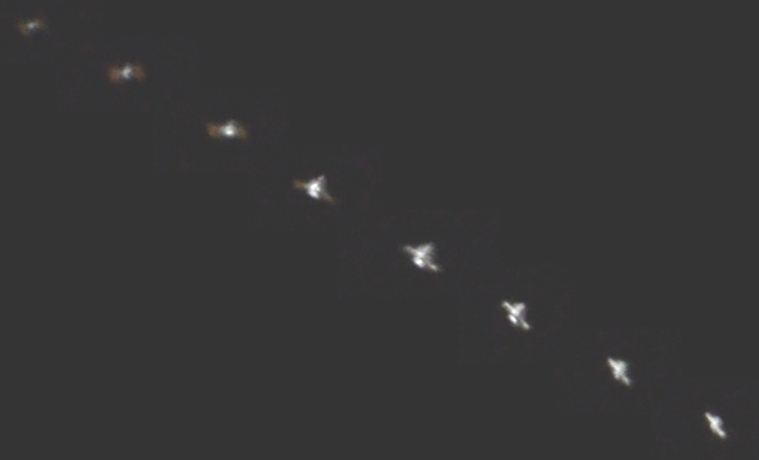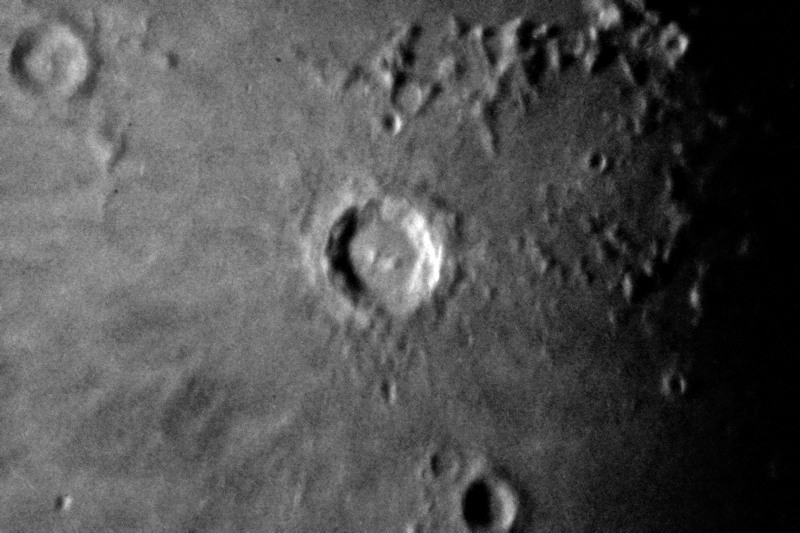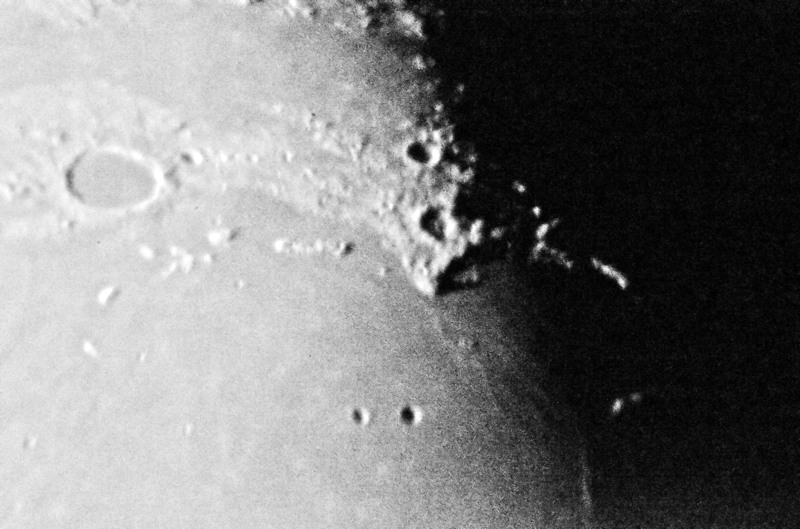
D7000 Imaging: Moon, Good ISS Sequence Thru Telescope
Posted: 3 March 2012
I had hoped to open the observatory Thursday evening, 1 March, but there was a strong wind blowing at the time. No observing. Winds continued on Friday, but mostly subsided around sunset. I opened the observatory Friday, 2 March 2012, at 1810 MST, 66°F. The sky was clear with just a little bit of haze visible. At 1817 MST, viewed Mercury, 77X and 206X. A "quarter-moon" phase was visible. Then viewed Venus, 77X. Also about a "quarter-moon" phase. Next was Jupiter, 77X. Four moons were visible. Seeing was not very good. At 1828 MST, I tried for Uranus but the sky was still too bright. So, I viewed the moon, also about a "quarter-moon" phase, 77X. I then updated the TLE for the International Space Station (ISS) on the AutoStar for this night's nice and long ISS pass. I then mounted my "POD Roller Desk" on the POD wall for its second night of use. At 1845 MST, I returned to Uranus, which was now visible. Viewed at 77X and 206X.
I began setting up for the ISS pass. I mounted the D7000 DSLR at prime focus of the 8" LX200-ACF. I focused on the moon and took this image, 1/1600sec, ISO 2000:

Next, I checked the finderscope alignment using Venus. At 1902 MST, I was ready for the ISS pass to start. It began at 1921 MST. I did a video recording for 6 minutes, 5 seconds, at 1/1600sec, ISO 2000. Although initial pointing was slightly off, tracking was pretty good during this pass. There were many usable frames in the video. This image shows the changing perspective during the long pass as the ISS rose above the northwestern horizon (left image), passed up to and through the zenith (middle images), and down to the southeastern horizon (right image).

After the ISS pass was completed, I unmounted the camera and did some lunar terminator observing at 133X and 206X. Seeing was not very good. At 1948 MST, I took a quick look at Mars, low in the east, 133X. Even though seeing was not very good, some dark surface areas were visible. Mars would be at opposition in about 17 hours so I was anxiously waiting for it to rise higher in the sky for better viewing. At 2016 MST, I went back to Jupiter, 133X. Seeing not good but it appeared that both the North Equatorial Belt (NEB) and South Equatorial Belt (SEB) were thinner than I recalled during recent nights. Are they fading?
At 2034 MST, I returned to the moon. Seeing was a little better so I decided to try some high magnification images using the D7000 DSLR and eyepiece projection at 222X. These images are slightly cropped from the full-frame image and taken at 1/250sec, ISO 5000. This is the crater Clavius:

And the crater Copernicus:

The view of Sinus Iridum was pretty nice, so I tried to capture the mountain shadows. This image doesn't do the view justice but shows the crater Plato on the left and Sinus Iridum on the right:

I unmounted the camera and beginning at 2131 MST, I did some more lunar observing at 364X and 133X. Seeing was fairly good and the sights along the terminator were very nice. I then went to Mars, now higher in the sky, and viewed it at 133X and 206X. Unfortunately, strong breezes were kicking up again. Seeing began deteriorating. At 2153 MST, I closed the dome due to the wind. (My iPod shutoff due to the low temperature, 41°F, so no more "Hearts of Space" music in the observatory.) I re-opened the dome at 2240 MST. The wind was still blowing but I took a look at Mars at 206X. Seeing was not good. Decided to end the session.
The observatory was closed at 2255 MST, 41°F.
Go to the previous report.
Return to the Cassiopeia Observatory Welcome Page.